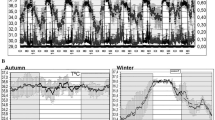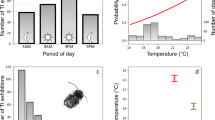Abstract
Newborn rabbits, like other altricial mammals, demonstrate thermotaxis and when placed on a thermal gradient locate and come to rest at physiologically appropriate temperatures. Little is known, however, about the sensory-motor components contributing to the in energetic terms important decision of the young to cease locomotion and come to rest. We investigated the behavior of newborn rabbits on two thermal gradients; linear in which pups could use tactile cues from the arena wall, and concentric in which pups were unable to use such cues. On both gradients pups located the warm, thermal-neutral area within the 200-s test time, thereby demonstrating their ability to orient appropriately using thermal cues alone. Unexpectedly, however, pups on the concentric gradient failed, or took significantly longer, to come to rest than pups on the linear gradient. Since the speed of locomotion of pups on the linear gradient was significantly slowed when they were in contact with the arena wall, and in most cases they came to rest in contact with it, we suggest that not only thermal but also tactile cues may be important in bringing young mammals to rest in a thermally appropriate environment.




Similar content being viewed by others
Abbreviations
- CG-C:
-
concentric gradient with pups started at the cool rim
- CG-W:
-
concentric gradient with pups started at the warm rim
- LG-C:
-
linear gradient with pups started at the cool end
- LG-W:
-
linear gradient with pups started at the warm end
- NG:
-
no gradient
References
Alberts JR (1978a) Huddling by rat pups: multisensory control of contact behavior. J Comp Physiol Psychol 92:220–230
Alberts JR (1978b) Huddling by rat pups: group behavioral mechanisms of temperature regulation and energy conservation. J Comp Physiol Psychol 92:231–245
Alberts JR, May B (1984) Nonnutritive, thermotactile induction of filial huddling in rat pups. Dev Psychobiol 17:161–181
Bernard E, Hull D (1964) The effect of environmental temperature on the growth of newborn rabbits reared in incubators. Biol Neonate 7:172–178
Blumberg MS, Sokoloff G (1998) Thermoregulatory competence and behavioral expression in the young of altricial species—revisited. Dev Psychobiol 33:107–123
Cardasis CA, Sinclair JC (1972) The effects of ambient temperature on the fasted newborn rabbit. I. Survival time, weight loss, body temperature and oxygen consumption. Biol Neonate 21:330–346
Dawkins MJR, Hull D (1964) Brown adipose tissue and the response of new-born rabbits to cold. J Physiol (Lond) 172:216–238
Freeman NCG, Rosenblatt JS (1978) The interrelationship between thermal and olfactory stimulation in the development of home orientation in newborn kittens. Dev Psychobiol 11:437–457
González-Mariscal G, Rosenblatt JS (1996) Maternal behavior in rabbits. In: Rosenblatt JS, Snowdon CT (eds) Parental care: evolution, mechanisms and adaptive significance. Academic Press, New York, pp 333–360
Hardman MJ, Hey EN, Hull D (1969a) The effect of prolonged cold exposure on heat production in new-born rabbits. J Physiol (Lond) 205:39–50
Hardman MJ, Hey EN, Hull D (1969b) Fat metabolism and heat production in young rabbits. J Physiol (Lond) 205:51–59
Harlow HF, Zimmermann RR (1959) Affectional responses in the infant monkey. Science 130:421–432
Heim T, Hull D (1966) The blood flow and oxygen consumption of brown adipose tissue in the new-born rabbit. J Physiol (Lond) 186:42–55
Hudson R, Distel H (1982) The pattern of behaviour of rabbit pups in the nest. Behaviour 79:255–271
Hudson R, Distel H (1989) Temporal pattern of suckling in rabbit pups: a model of circadian synchrony between mother and young. In: Reppert SM (ed) Development of circadian rhythmicity and photoperiodism in mammals. Perinatology Press, Boston, pp 83–102
Hull D (1965) Oxygen consumption and body temperature of new-born rabbits and kittens exposed to cold. J Physiol (Lond) 177:192–202
Hull J, Hull D (1982) Behavioral thermoregulation in newborn rabbits J Comp Physiol Psychol 96:143–147
Hull D, Segall MM (1965a) The contribution of brown adipose tissue to heat production in the new-born rabbit. J Physiol (Lond) 181:449–457
Hull D, Segall MM (1965b) Sympathetic nervous control of brown adipose tissue and heat production in the new-born rabbit. J Physiol (Lond) 181:458–467
Hull D, Segall MM (1965c) Heat production in the new-born rabbit and the fat content of the brown adipose tissue. J Physiol (Lond) 181:468–477
Jeddi E (1971) Thermoregulatory efficiency of neonatal rabbit search for fur comfort contact. Int J Biometeorol 15:337–341
Johanson IB (1979) Thermotaxis in neonatal rat pups. Physiol Behav 23:871–874
Kleitman N, Satinoff E (1981) Behavioral responses to pyrogen in cold-stressed and starved newborn rabbits. Am J Physiol 241:R167–172
Krasnegor NA, Bridges RS (1990) Mammalian parenting: biochemical, neurobiological and behavioral determinants. Oxford University Press, New York
Leonard C (1974) Thermotaxis in golden hamster pups. J Comp Physiol Psychol 3:458–469
Leonard C (1982) Shifting strategies of behavioral thermoregulation in developing golden hamsters. J Comp Physiol Psychol 96:234–243
Ogilvie DM, Stinson RH (1966) The effect of age on temperature selection by laboratory mice (Mus musculus) Can J Zool 44:511–517
Oswalt GL, Meier GW (1975) Olfactory, thermal and tactual influences on infantile ultrasonic vocalization in rats. Dev Psychobiol 8:129–135
Rheingold HL (1963) Maternal behavior in mammals. Wiley, New York
Rouvinen-Watt K, Harri M (2001) Observations on thermoregulatory ontogeny of mink (Mustela vison). J Therm Biol 26:9–14
Satinoff E, McEwen GN, Williams BA (1976) Behavioral fever in newborn rabbits. Science 193:1139–1140
Scafidi FA, Field TM, Schanberg SM, Bauer CR, Vega-Lahr N, Garcia R, Poirier J, Nystrom G, Kuhn CM (1986) Effects of tactile/kinesthetic stimulation on the clinical course and sleep/wake behavior of preterm neonates. Infant Behav Dev 9:91–105
Schanberg S, Evoniuk G, Kuhn CM (1984) Tactile and nutritional aspects of maternal care: specific regulators of neuroendocrine function and cellular development. Proc Soc Exp Biol Med 175:135–146
Sokal M, Sinclair J (1976) Effect of temperature on growth of newborn rabbits. Biol Neonate 28:1–11
Sullivan RM, Hall WG (1988) Reinforcers in infancy: classical conditioning using stroking or intra-oral infusions of milk as a UCS. Dev Psychobiol 21:215–223
Sullivan RM, Hofer MA, Brake SC (1986) Olfactory-guided orientation in neonatal rats is enhanced by a conditioned change in behavioral state. Dev Psychobiol 19:615–623
Sullivan RM, Wilson DA, Leon M (1988) Associative processes in early olfactory preference acquisition: neural and behavioral consequences. Psychobiol 17:29–33
Sullivan RM, Taborsky-Barba S, Mendoza R, Itano A, Leon M, Cotman CW, Payne TF, Lott I (1991) Olfactory classical conditioning in neonates. Pediatrics 87:511–518
Várnai I, Farkas M, Donhoffer SZ (1970) Thermoregulatory heat production and the regulation of body temperature in the new born rabbit. Acta Physiol Acad Sci Hung 38:299–315
Acknowledgements
Support from PAPIIT grant IN217100 is gratefully acknowledged and we thank Carolina Rojas Castañeda for excellent technical assistance. The experiments comply with the Principles of Animal Care, publication No. 86-23, revised 1985 of the National Institutes of Health, USA, and with the current laws of Mexico.
Author information
Authors and Affiliations
Corresponding author
Rights and permissions
About this article
Cite this article
Pacheco-Cobos, L., Rosetti, M., Distel, H. et al. To stay or not to stay: the contribution of tactile and thermal cues to coming to rest in newborn rabbits. J Comp Physiol A 189, 383–389 (2003). https://doi.org/10.1007/s00359-003-0413-3
Received:
Revised:
Accepted:
Published:
Issue Date:
DOI: https://doi.org/10.1007/s00359-003-0413-3




